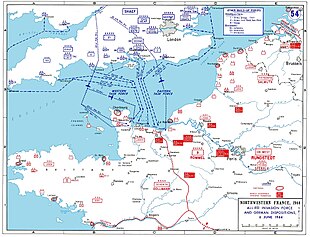| Sword | |||||||
|---|---|---|---|---|---|---|---|
| Part of Normandy landings and the Battle for Caen | |||||||
 British infantry waiting to move off Queen Beach, SWORD Area, while under heavy enemy fire, on the morning of 6 June | |||||||
| |||||||
| Belligerents | |||||||
|
| |||||||
| Commanders and leaders | |||||||
|
|
| ||||||
| Strength | |||||||
|
28,845[1] 223 tanks[2] |
8 infantry companies (716th Infantry Division)[nb 1] 9,790 124–127 tanks[5][6] 40 assault guns[5] (21st Panzer Division)[nb 2] | ||||||
| Casualties and losses | |||||||
| 683 casualties[nb 3] |
unknown casualties 40[6]–54 tanks lost[nb 4] 6 bombers destroyed[13] | ||||||

Sword, commonly known as Sword Beach, was the code name given to one of the five main landing areas along the Normandy coast during the initial assault phase, Operation Neptune, of Operation Overlord. The Allied invasion of German-occupied France commenced on 6 June 1944. Stretching 8 kilometres (5.0 mi) from Ouistreham to Saint-Aubin-sur-Mer, the beach proved to be the easternmost landing site of the invasion after the abortion of an attack on a sixth beach, code-named Band. Taking Sword was to be the responsibility of the British Army with sea transport, mine sweeping and a naval bombardment force provided by the British Royal Navy as well as elements from the Polish, Norwegian and other Allied navies.
Among the five beaches of the operation, Sword is the nearest to Caen, about 15 kilometres (9.3 mi) from the goal of the 3rd Infantry Division. The landings were achieved with low Allied casualties but the advance from the beach was slowed by traffic congestion and resistance in defended areas behind the beach. Further progress towards Caen was halted by the only armoured counter-attack of the day, mounted by the 21st Panzer Division.
Cite error: There are <ref group=nb> tags on this page, but the references will not show without a {{reflist|group=nb}} template (see the help page).